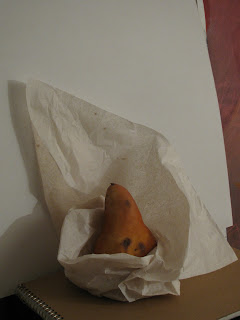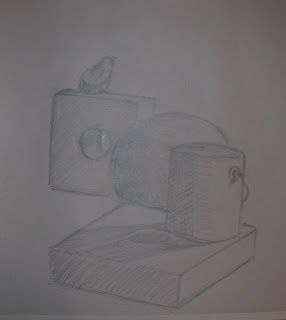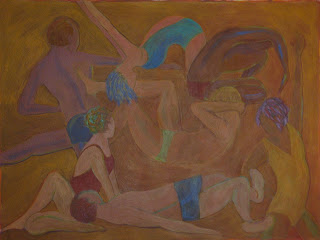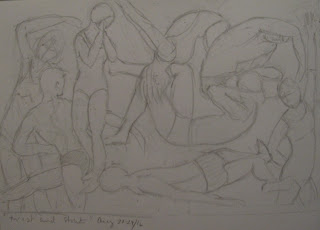Saturday, December 31, 2016
Neither snow nor rain nor gloom of night...
The rain was endless, and the late afternoons were gloomy, but I headed out to every art class until......yes, The Snow finally kept me from my appointed rounds. I missed the very last one (so did others, I suspect) -- but we had lots to show for Classes 5, 6, 7.
First, a whirl at gesture drawing -- quick studies that aim to capture essence rather than exactitude. I've worked with these for years, following Nicolaides' counsel to capture the movement of the pose. Our teacher Frances had her own distinctive approach, which was new and valuable to me. In 3-5 minute poses by a terrific male model, we were to emphasize "the HOW" of the movement:-- the places that showed weight and tension.
Shifting speed, we did contour drawings -- another long-time favourite of mine. The objective is to achieve eye/hand coordination, keeping your eye moving very slowly across every millimetre of a selected contour on the model's body and moving your marker at the same pace. The most exacting exercises are "blind contours" -- when your eye concentrates wholly on the model, and you NEVER look at your paper (well, maybe a teeny peek if you're really feeling lost).
I've always loved the way that, despite the inexactitude, blind contours pick up idiosyncrasies that make the drawing very engaging.
We were introduced to the blind contour drawings of an artist I'd never heard of, Elizabeth Layton, who made them her life's work -- starting at the age of 83! With her examples in mind, we were given the homework assignment to do a self-portrait in blind contour, including things of interest or importance to us. In late November, I knew exactly what I would do. I felt compelled to borrow the words of now deceased US Senator Robert Byrd who, it's been said, carried a copy of the US Constitution in his pocket. In the early 2000s, when the US rolled out its first Patriot Act with its sweeping curtailment of civil liberties, Byrd was quoted as saying, "Today I weep for my country." And this was the motivation and title for my self-portrait.
This was decidedly the best work I did in this course. The room fell silent when it came my turn to show my homework and explain its title. One of my quick-witted foreign classmates said, "Ha! The US election!!!" And a shy young Japanese girl crept close to my elbow and asked solemnly, "Is it because of Donald Trump?"
Well. Then we went on to put things in perspective. The first and easiest: One-point perspective.
Then, two-point perspective.
After this warm-up, our homework was to create an imaginary street scene in perspective.
Get it?
My final class before the snowstorm was itself a whirlwind. Remember those 100 seashells I did as my first homework? Frances wanted us to reconnect with the fun and excitement of making different kinds of marks. Our models were two chairs -- a 100-year-old fiddleback chair of her family's and a simple café chair. She continually repositioned the two so they were linked, separate, upside down, sideways, and so on.
With three minutes per pose, I only managed one chair each time. Here's the first, under the heading, "Loosen up and have fun."
This one, a favourite of mine, is done with two hands, each holding a different medium.
And this is about as good as you get -- or as good as I got -- drawing with a piece of charcoal attached to a 4-foot dowel. (the café chair with its patterned seat)
We then had a stretch of time to choose and draw details of the chairs -- and their negative spaces. (this is the back of the fiddleback chair upside-down)
Our homework assignment was to select from our collection of chair details and make an abstract drawing.
Alas, the snow blew in, and my abstraction never received a group critique. Instead, I stayed home in The Yellow House and looked down from my front porch at the work of other mark-makers.
Monday, December 12, 2016
Making my mark
Well, mark making was the name of the game as I continued my "Fundamentals of Drawing" course at Emily Carr University of Art & Design.
After plunging in with 100 drawings of the same object, we settled down quickly to master some essential skills. First up:-- Developing grey scales using different media. Object: In ten evenly graduated steps, create a band of tones from white to black.
This can be fiendishly difficult. Zoom into the blob in the lower left corner below, and you'll detect an exasperated, "I give up."
With that mastered (ha!), we used these tonal basics to make geometric shapes appear as three-dimensional as possible.
.
Our homework assignment was to use the same techniques to draw one or more pears, as 3-dimensionally as possible.
Approaching the midpoint of the course, we learned that useful knack of Looking Like Real Artists. You know:-- holding a pencil out at arm's length to assist in gauging proportion and comparative sizes. Using this method in class to lay out some differently sized and positioned objects seemed awkward to me.
...but I had fun replicating the arm's-length pose at home:
The following week we experimented with creating textures. Our homework was to draw five identical objects and cover them with improbable textures. How about these light bulbs decked out in crumpled paper, puckered fabric, wrapped yarn, snakeskin, and tire treads?
To make all the tiny little marks that comprise the whole takes hours and hours, but it can also have a calm and meditative effect -- just what I needed.
Our homework assignments became more challenging with each week -- a lot to cover in just one blog post. So I've decided to continue next time with the adventures of the following three classes. What do you think? A bright idea, no?
Friday, November 25, 2016
Second thoughts, second try
Does this look familiar? It was my first try at "Twist and Shout - #2 in the Flash Mob Series", just after a long second thought about its progress led me to paint it over and aim for a second try. As I confessed before, a series of dubious decisions had led me to this disorderly mob:
I went back to square one, the original pencil layout of eight figures --
Although I planned to change some of these, I was determined not to invite any additional guests to the party.
Things went pretty smoothly this time. As the figures developed, I tried out different background colours.
And at last, I signed off on the final version. (You can see the steps along the way here. Not at all as much fun as they used to be in the old Picasa slideshows).
That's not to say that this is the final painting in the series. Just remember: Flash Mobs are everywhere.
Sunday, October 30, 2016
Listen up!
It's back to school time, and there's lots to learn. I've headed off to Emily Carr University of Art and Design for a continuing studies course in Fundamentals of Drawing.
No, this is not me -- unless in an alternate universe. (And if you'd like a mini-photo tour of my walk through Granville Island that brought me to this point, click here.)
Our instructor Frances (whose magnificent and large-scale drawings of trees are shown here) is passionate about drawing and reminds us that, "Some of the basics you might find tedious, but you must do them again and again to learn your craft. And if you find it too boring -- maybe drawing is just not for you."
Our utilitarian classroom has lots of good vibes from art students who have been willing to hunker down and get on with it.
In our first class, we experimented with making different kinds of marks with different kinds of media. Our first week's assignment was to select a simple object we liked and to spend three hours drawing it with different tools -- "Oh, maybe 100 drawings," Frances said. Gulp. What's more, each drawing was to express an adjective of emotion or line quality.
Back home, I gathered my forces and materials -- 100 smallish sheets of different kinds of paper,
...an array of drawing tools....
a Florida seashell I've had since I was ten years old and, oh yes, a list I developed of 100 adjectives.
Are you ready? I won't hit you with all one-hundred, but here's a start:
At about Drawing #20, I understood why Frances suggested we choose an object that we liked. It would have been grueling to do this with something to which one was indifferent.
Oh, let's do one more:
I hope this has been an intelligent and informative post. If not, I think it at least meets the specifications of the graffiti on the air conditioning unit outside our ECUAD classroom.
Sunday, October 16, 2016
Make no mistake...
You've probably heard of writers saying that as they worked on their novels, their characters took on a life of their own and told their own story in a way that had never been planned. Sometimes a painting develops like this.
"In my case all painting... is an accident. I foresee it and yet I hardly ever carry it out as I foresee it. It transforms itself by the actual paint. I don't in fact know very often what the paint will do, and it does many things which are very much better than I could make it do. "
- Francis Bacon
There seems to be a fine line between planning ahead and going with the flow -- "listening" to the painting and embracing any accidents or mistakes. (But let's leave Francis Bacon's own paintings for another day -- or maybe never).
I've been on a roll lately, continuing with my "Flash Mob" series. I'd expected in this post to be unveiling the second in the series, "Twist and Shout." Here's my scale pencil study:
I know my work has a tendency to get too tight, and once again -- rather than do a methodical scaled layout -- I decided to plunge right out. I roughed in all the figures on my large sheet, and they seemed to be going brilliantly. But then I saw that I'd left far too much space between the sprawled figure at the bottom and the central figure with knees bent.
Well, what of it? I would just add another figure to link them vertically on the page. After all........
"The man who makes no mistakes does not usually make anything."
- Edward Phelps
And I *really* liked the way this figure began to shape up.
I also didn't like a large figure with outstretched arms from my very first pencil sketch. But I *loved* the results when I replaced it with this doubled-over figure, stretching arms over her back.
What the heck? I was working in a time-honoured tradition here.
"You have to know how to use the accident, how to recognise it, how to control it, and ways to eliminate it so that the whole surface looks felt and born all at once."
- Helen Frankenthaler
One of the constants from the early layout was the female figure on the right side -- and by golly, her leg started looking like something Toulouse-Lautrec could be proud of, I thought modestly:
At the outset, I hadn't quite seen how my complementary colours would take an adventurous turn, but it was happening.
"Only now I'm learning to enjoy not being in charge of what the next stroke will do to the whole painting. I'm still learning that there are no mistakes only discoveries."
- Fernando Araujo
But still, I hadn't quite solved the problem identified in Week One:-- the excess space between the two guys in the centre. I decided I'd better add another figure in there.
It wasn't quite right, though, even four days later. Maybe something larger?
I plodded along for another four days, and this wasn't right either. Remember the flash mob of impulses and ideas I've reported as showing up in my studio each morning?
They were starting to complain -- loudly. It was turning into a riot!! At the same time, one of the lights in my studio burned out -- but another light went on.
Face it:-- This was not working. Despite all my enthusiastic accommodation of the original mistake of too much space in the middle...........the whole thing was still a mistake.
I thought it over for 24 hours, and the next morning I turned the paper upside-down...
and painted the whole thing over:--
I've started again -- back at the original pencil sketch -- consoling myself with the thought that I've truly grasped the lesson of contemporary artist/writer Richard Schmidt, one of whose maxims is: "Never leave a mistake on the easel."
It can only get better, right? And Scott Adams, creator of "Dilbert," sets the bar high: "Creativity is allowing yourself to make mistakes. Art is knowing which ones to keep." (It's worth following this link just to see what Adams had to say back in March about everyone's unfavourite presidential candidate).
You'll be seeing more of the "Flash Mob Series" very soon. And just look around you -- flash mobs are everywhere.
Subscribe to:
Posts (Atom)



























































